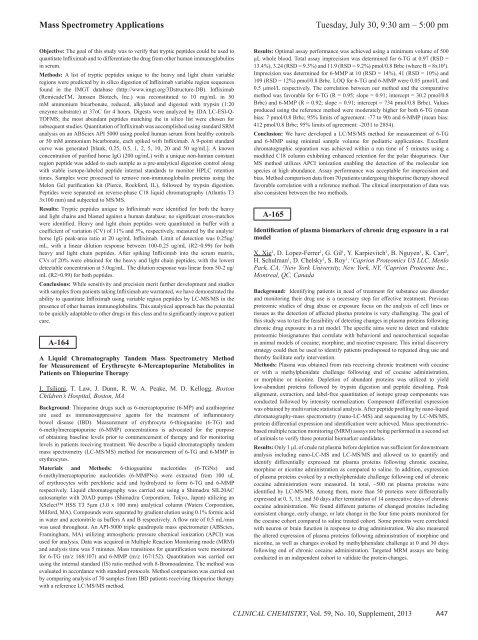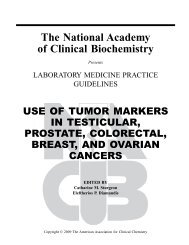Abstracts of the Scientific Posters, 2013 AACC Annual Meeting ...
Abstracts of the Scientific Posters, 2013 AACC Annual Meeting ...
Abstracts of the Scientific Posters, 2013 AACC Annual Meeting ...
Create successful ePaper yourself
Turn your PDF publications into a flip-book with our unique Google optimized e-Paper software.
Mass Spectrometry Applications<br />
Tuesday, July 30, 9:30 am – 5:00 pm<br />
Objective: The goal <strong>of</strong> this study was to verify that tryptic peptides could be used to<br />
quantitate Infliximab and to differentiate <strong>the</strong> drug from o<strong>the</strong>r human immunoglobulins<br />
in serum.<br />
Methods: A list <strong>of</strong> tryptic peptides unique to <strong>the</strong> heavy and light chain variable<br />
regions were predicted by in silico digestion <strong>of</strong> Infliximab variable region sequences<br />
found in <strong>the</strong> IMGT database (http://www.imgt.org/3Dstructure-DB). Infliximab<br />
(RemicadeTM, Janssen Biotech, Inc.) was reconstituted to 10 mg/mL in 50<br />
mM ammonium bicarbonate, reduced, alkylated and digested with trypsin (1:20<br />
enzyme:substrate) at 37oC for 4 hours. Digests were analyzed by IDA LC-ESI-Q-<br />
TOFMS; <strong>the</strong> most abundant peptides matching <strong>the</strong> in silico list were chosen for<br />
subsequent studies. Quantitation <strong>of</strong> Infliximab was accomplished using standard SRM<br />
analysis on an ABSciex API 5000 using pooled human serum from healthy controls<br />
or 50 mM ammonium bicarbonate, each spiked with Infliximab. A 9-point standard<br />
curve was generated [blank, 0.25, 0.5, 1, 2, 5, 10, 20 and 50 ug/mL]. A known<br />
concentration <strong>of</strong> purified horse IgG (200 ug/mL) with a unique non-human constant<br />
region peptide was added to each sample as a pre-analytical digestion control along<br />
with stable isotope-labeled peptide internal standards to monitor HPLC retention<br />
times. Samples were processed to remove non-immunoglobulin proteins using <strong>the</strong><br />
Melon Gel purification kit (Pierce, Rockford, IL), followed by trypsin digestion.<br />
Peptides were separated on reverse-phase C18 liquid chromatography (Atlantis T3<br />
3x100 mm) and subjected to MS/MS.<br />
Results: Tryptic peptides unique to Infliximab were identified for both <strong>the</strong> heavy<br />
and light chains and blasted against a human database; no significant cross-matches<br />
were identified. Heavy and light chain peptides were quantitated in buffer with a<br />
coefficient <strong>of</strong> variation (CV) <strong>of</strong> 11% and 5%, respectively, measured by <strong>the</strong> analyte/<br />
horse IgG peak-area ratio at 20 ug/mL Infliximab. Limit <strong>of</strong> detection was 0.25ug/<br />
mL, with a linear dilution response between 100-0.25 ug/mL (R2>0.99) for both<br />
heavy and light chain peptides. After spiking Infliximab into <strong>the</strong> serum matrix,<br />
CVs <strong>of</strong> 20% were obtained for <strong>the</strong> heavy and light chain peptides, with <strong>the</strong> lowest<br />
detectable concentration at 5.0ug/mL. The dilution response was linear from 50-2 ug/<br />
mL (R2>0.99) for both peptides.<br />
Conclusions: While sensitivity and precision merit fur<strong>the</strong>r development and studies<br />
with samples from patients taking Infliximab are warranted, we have demonstrated <strong>the</strong><br />
ability to quantitate Infliximab using variable region peptides by LC-MS/MS in <strong>the</strong><br />
presence <strong>of</strong> o<strong>the</strong>r human immunoglobulins. This analytical approach has <strong>the</strong> potential<br />
to be quickly adaptable to o<strong>the</strong>r drugs in this class and to significantly improve patient<br />
care.<br />
A-164<br />
A Liquid Chromatography Tandem Mass Spectrometry Method<br />
for Measurement <strong>of</strong> Erythrocyte 6-Mercaptopurine Metabolites in<br />
Patients on Thiopurine Therapy<br />
I. Tsilioni, T. Law, J. Dunn, R. W. A. Peake, M. D. Kellogg. Boston<br />
Children’s Hospital, Boston, MA<br />
Background: Thiopurine drugs such as 6-mercaptopurine (6-MP) and azathioprine<br />
are used as immunosuppressive agents for <strong>the</strong> treatment <strong>of</strong> inflammatory<br />
bowel disease (IBD). Measurement <strong>of</strong> erythrocyte 6-thioguanine (6-TG) and<br />
6-methylmercaptopurine (6-MMP) concentrations is advocated for <strong>the</strong> purpose<br />
<strong>of</strong> obtaining baseline levels prior to commencement <strong>of</strong> <strong>the</strong>rapy and for monitoring<br />
levels in patients receiving treatment. We describe a liquid chromatography tandem<br />
mass spectrometry (LC-MS/MS) method for measurement <strong>of</strong> 6-TG and 6-MMP in<br />
erythrocytes.<br />
Materials and Methods: 6-thioguanine nucleotides (6-TGNs) and<br />
6-methylmercaptopurine nucleotides (6-MMPNs) were extracted from 100 uL<br />
<strong>of</strong> erythrocytes with perchloric acid and hydrolyzed to form 6-TG and 6-MMP<br />
respectively. Liquid chromatography was carried out using a Shimadzu SIL20AC<br />
autosampler with 20AD pumps (Shimadzu Corporation, Tokyo, Japan) utilizing an<br />
XSelect HSS T3 5μm (3.0 x 100 mm) analytical column (Waters Corporation,<br />
Milford, MA). Compounds were separated by gradient elution using 0.1% formic acid<br />
in water and acetonitrile as buffers A and B respectively. A flow rate <strong>of</strong> 0.5 mL/min<br />
was used throughout. An API-5000 triple quadropole mass spectrometer (ABSciex,<br />
Framingham, MA) utilizing atmospheric pressure chemical ionization (APCI) was<br />
used for analysis. Data was acquired in Multiple Reaction Monitoring mode (MRM)<br />
and analysis time was 5 minutes. Mass transitions for quantification were monitored<br />
for 6-TG (m/z 168/107) and 6-MMP (m/z 167/152). Quantitation was carried out<br />
using <strong>the</strong> internal standard (IS) ratio method with 8-Bromoadenine. The method was<br />
evaluated in accordance with standard protocols. Method comparison was carried out<br />
by comparing analysis <strong>of</strong> 70 samples from IBD patients receiving thiopurine <strong>the</strong>rapy<br />
with a reference LC/MS/MS method.<br />
Results: Optimal assay performance was achieved using a minimum volume <strong>of</strong> 500<br />
μL whole blood. Total assay imprecision was determined for 6-TG at 0.97 (RSD =<br />
13.4%), 3.24 (RSD = 9.3%) and 11.9 (RSD = 9.2%) pmol/0.8 Brbc (where B = 8x10 8 ).<br />
Imprecision was determined for 6-MMP at 10 (RSD = 14%), 41 (RSD = 10%) and<br />
109 (RSD = 12%) pmol/0.8 Brbc. LOQ for 6-TG and 6-MMP were 0.05 μmol/L and<br />
0.5 μmol/L respectively. The correlation between our method and <strong>the</strong> comparative<br />
method was favorable for 6-TG (R = 0.95; slope = 0.91; intercept = 30.2 pmol/0.8<br />
Brbc) and 6-MMP (R = 0.92; slope = 0.91; intercept = 734 pmol/0.8 Brbc). Values<br />
produced using <strong>the</strong> reference method were moderately higher for both 6-TG (mean<br />
bias: 7 pmol/0.8 Brbc; 95% limits <strong>of</strong> agreement: -77 to 90) and 6-MMP (mean bias:<br />
412 pmol/0.8 Brbc; 95% limits <strong>of</strong> agreement: -2031 to 2854).<br />
Conclusion: We have developed a LC/MS/MS method for measurement <strong>of</strong> 6-TG<br />
and 6-MMP using minimal sample volume for pediatric applications. Excellent<br />
chromatographic separation was achieved within a run time <strong>of</strong> 5 minutes using a<br />
modified C18 column exhibiting enhanced retention for <strong>the</strong> polar thiopurines. Our<br />
MS method utilizes APCI ionization enabling <strong>the</strong> detection <strong>of</strong> <strong>the</strong> molecular ion<br />
species at high abundance. Assay performance was acceptable for imprecision and<br />
bias. Method comparison data from 70 patients undergoing thiopurine <strong>the</strong>rapy showed<br />
favorable correlation with a reference method. The clinical interpretation <strong>of</strong> data was<br />
also consistent between <strong>the</strong> two methods.<br />
A-165<br />
Identification <strong>of</strong> plasma biomarkers <strong>of</strong> chronic drug exposure in a rat<br />
model<br />
X. Xie 1 , D. Lopez-Ferrer 1 , G. Gil 1 , Y. Karpievitch 1 , B. Nguyen 1 , K. Carr 2 ,<br />
H. Schulman 1 , D. Chelsky 3 , S. Roy 1 . 1 Caprion Proteomics US LLC, Menlo<br />
Park, CA, 2 New York University, New York, NY, 3 Caprion Proteome Inc.,<br />
Montreal, QC, Canada<br />
Background: Identifying patients in need <strong>of</strong> treatment for substance use disorder<br />
and monitoring <strong>the</strong>ir drug use is a necessary step for effective treatment. Previous<br />
proteomic studies <strong>of</strong> drug abuse or exposure focus on <strong>the</strong> analysis <strong>of</strong> cell lines or<br />
tissues as <strong>the</strong> detection <strong>of</strong> affected plasma proteins is very challenging. The goal <strong>of</strong><br />
this study was to test <strong>the</strong> feasibility <strong>of</strong> detecting changes in plasma proteins following<br />
chronic drug exposure in a rat model. The specific aims were to detect and validate<br />
proteomic biosignatures that correlate with behavioral and neurochemical sequelae<br />
in animal models <strong>of</strong> cocaine, morphine, and nicotine exposure. This initial discovery<br />
strategy could <strong>the</strong>n be used to identify patients predisposed to repeated drug use and<br />
<strong>the</strong>reby facilitate early intervention.<br />
Methods: Plasma was obtained from rats receiving chronic treatment with cocaine<br />
or with a methylphenidate challenge following end <strong>of</strong> cocaine administration,<br />
or morphine or nicotine. Depletion <strong>of</strong> abundant proteins was utilized to yield<br />
low-abundant proteins followed by trypsin digestion and peptide desalting. Peak<br />
alignment, extraction, and label-free quantitation <strong>of</strong> isotope group components was<br />
conducted followed by intensity normalization. Component differential expression<br />
was obtained by multivariate statistical analysis. After peptide pr<strong>of</strong>iling by nano-liquid<br />
chromatography-mass spectrometry (nano-LC-MS) and sequencing by LC-MS/MS,<br />
protein differential expression and identification were achieved. Mass spectrometricbased<br />
multiple reaction monitoring (MRM) assays are being performed in a second set<br />
<strong>of</strong> animals to verify <strong>the</strong>se potential biomarker candidates.<br />
Results: Only 1 μL <strong>of</strong> crude rat plasma before depletion was sufficient for downstream<br />
analysis including nano-LC-MS and LC-MS/MS and allowed us to quantify and<br />
identify differentially expressed rat plasma proteins following chronic cocaine,<br />
morphine or nicotine administration as compared to saline. In addition, expression<br />
<strong>of</strong> plasma proteins evoked by a methylphenidate challenge following end <strong>of</strong> chronic<br />
cocaine administration were measured. In total, ~500 rat plasma proteins were<br />
identified by LC-MS/MS. Among <strong>the</strong>m, more than 50 proteins were differentially<br />
expressed at 0, 3, 15, and 30 days after termination <strong>of</strong> 14 consecutive days <strong>of</strong> chronic<br />
cocaine administration. We found different patterns <strong>of</strong> changed proteins including<br />
consistent change, early change, or late change in <strong>the</strong> four time points monitored for<br />
<strong>the</strong> cocaine cohort compared to saline treated cohort. Some proteins were correlated<br />
with neuron or brain function in response to drug administration. We also measured<br />
<strong>the</strong> altered expression <strong>of</strong> plasma proteins following administration <strong>of</strong> morphine and<br />
nicotine, as well as changes evoked by methylphenidate challenge at 0 and 30 days<br />
following end <strong>of</strong> chronic cocaine administration. Targeted MRM assays are being<br />
conducted in an independent cohort to validate <strong>the</strong> protein changes.<br />
CLINICAL CHEMISTRY, Vol. 59, No. 10, Supplement, <strong>2013</strong><br />
A47
















